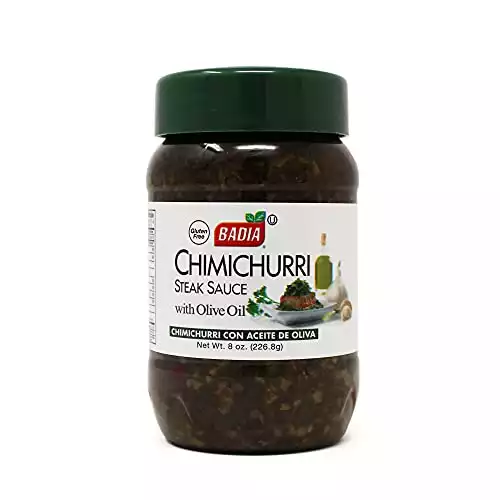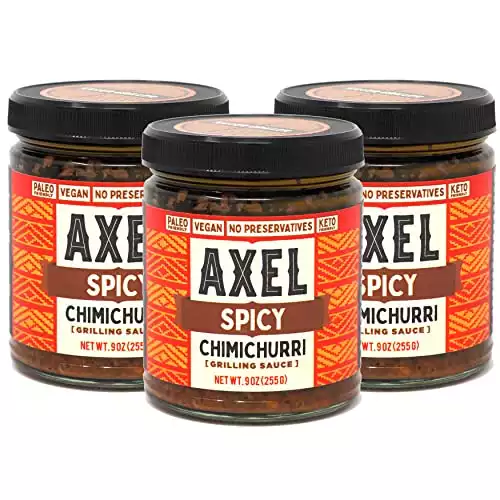If you have never tried this sauce, prepare to be amazed. It resembles pesto but lacks cheese and nuts and focuses more on acidic vinegar. Chimichurri pairs wonderfully with almost anything, including steak, chicken, lamb chops, fish, veggies, and much more. It is straightforward and refreshing.
We’ll explore everything chimichurri throughout this article. Still, if we were to characterize the condiment in one term, it would have been “bright.” a sauce could significantly improve a food, transforming it from basic to extraordinary. You’ll be astounded at how simple it is to pull this off.
What Does It Taste Like?

Organic cilantro plus parsley gives this sauce its herbaceous flavor, whereas red pepper flakes add just a hint of spiciness.
Chimichurri is created by combining the acidic tang of vinegar with garlic’s spicy, aromatic flavor. It has a robust, fresh flavor, yet the richness throughout the olive oil gives it a smooth, harmonious finish.
The vibrant flavors of chimichurri cut through into the flavorful fullness of Argentina’s famous grilled flank steak and every other grilled meat. It’s bursting with rich herbal crispness and is tangy, citrusy, garlicky, slightly spicy, and peppery. It is indeed a taste bomb, making sure all that it comes in contact with this is oozing with richness.
The lively edge of red wine vinegar is complemented by the herbal power of bright parsley, the rustic, peppery strength of oregano, the spiciness of garlic, and the fire of red chili peppers.
Strong spices are abundant in the sauce, and the crystalline olive oil unites them to provide a delightful, harmonious depth of flavor. For the chimichurri sauce’s rich taste to emerge, it is dished at ambient temperature onto sizzling steaks or vegetables.
What Is Chimichurri Sauce, Exactly?
Spices, olive oil, garlic, red wine vinegar, and fresh herbs are used to make the chimichurri sauce. This unprocessed sauce could be drizzled onto meat, veggies, and other foods as a seasoning and used as a condiment or sauce.
The sauce is from Argentina and Uruguay, in which roasted meats are usually topped with it. In addition to a variety of herbs, it occasionally includes hot spicy peppers and red pepper flakes. Popular spices include parsley, cilantro, and oregano. There’s still a red chimichurri version prepared to utilize red peppers and tomatoes, although it can often be created using green components.
Is Chimichurri Supposed To Be Spicy?

One thing that people ask about chimichurri sauce would be, “is it supposed to be spicy?” Yes, would then be the response. The chimichurri is hot. This results from the wide range of spices and herbs utilized in the sauce. With all these ingredients, the spiciness of this sauce will fill your mouth for a while.
Garlic, olive oil, finely minced parsley, red wine vinegar, oregano, plus seasonings are used to make green chimichurri. The hotter among the 2, red chimichurri, frequently contains smoked paprika, dried red chile, chili powder, or pepper flakes. Red bell pepper is even included in some recipes.
How Was Chimichurri Named?
Although the origins of chimichurri are shrouded in legend, it is most probable that cowboys known as gringos was using the sauce to flavor the pork they barbecued over camp flames on the pampas.
Others believe that it was invented by an Irish soldier named “Jimmy McCurry,” who could be either an independence warrior or perhaps a meat salesman who traveled with native fighters for Argentina’s sovereignty. Jimmy’s curry became chimichurri since his name was challenging for Argentines to enunciate.
Even so, it is more likely that the term is derived from said Basque word tximitxurri, which means “a combination of countless factors in no specific pattern.”
Numerous Chimichurri Sauces

You are welcome to substitute other leafy green components for cilantro and parsley because chimichurri sauce has become adaptable. Arugula and fresh oregano can be combined to produce a dressing with more heat. You could even use organic kale, spinach, swiss chard, dill, mint, and certain other vegetables.
What Distinguishes Pesto From Chimichurri?
Compared to pesto, which looks more like a puree, chimichurri is heavier and contains more different liquids and solids. The primary difference between the sauces, which come from several countries, is the ingredient employed in their preparation.
What Is the Purpose of Chili Seasoning?
Chimichurri seasoning includes oregano, dried parsley, garlic powder, other herbs and spices, and onion powder. It is often referred to as a crumbly rub or drier marinade. You can manufacture or purchase chimichurri seasoning if you wouldn’t have any local ingredients available.
You can create Chimichurri sauce with dry
The Foundational Chimichurri Sauce
The ingredients of chimichurri sauce, which include vibrant, fresh herbs, olive oil, salt, and pepper, are remarkably similar to those of pesto. There are countless variants on the basic chimichurri recipe, just as there are with pesto.
The most straightforward recipe merely calls for olive oil, parsley, vinegar or lemon juice, shallots or garlic, pepper, and salt. Oregano with crushed red pepper is commonly used in recipes.
You can quickly process sauce in something like a mixing bowl. The sauce is then ready to use as a ranch dressing, a seasoning for meats and fish, and a condiment.
More Facts About Chimichurri
Chimichurri isn’t pesto.
Not all Argentine pestos are chimichurri. Despite having similar looks, several have unique flavors. Basil, olive oil, garlic, almonds, and cheese are pesto ingredients. In such a chimichurri, various herbs, parsley, vegetables, and certain other spices are combined with oil, vinegar, water, and other components. Pasta and pesto go together. Roasted meats go well with chimichurri.
It is not really ketch-upped from Argentina.
Chimichurri is indeed not ketchup’s equivalent in Argentina. Argentines use ketchup in much the same way in neighboring countries. Something you won’t see is folks covering their marinated meats in ketchup. Chimichurri is used for it. Neither crispy potatoes nor hot dogs nor hamburgers should be dipped in Chimichurri.
It is better to use as condiment.
A marinade is not a Chimichurri. It is mostly used as an ingredient in barbecued meats, sausages, and organ meats. It is better to use Chimichurri as a condiment than a marinade.
Closing Thoughts: How Do You Enjoy Chimichurri Sauce?
Although there are endless purposes for such a vivid herb sauce, classically, chimichurri is most often used to spruce up a straightforward marinated steak or chicken as an element of something like the Argentinian Asado or barbecue.
It tastes well slathered over salmon, pig, or chorizo, marinated, dripped over veggies or cheese, using it as a condiment for crudité and toast, and transformed into a caesar dressing by adding more oil and vinegar. With such a sauce, your options are truly limitless.







